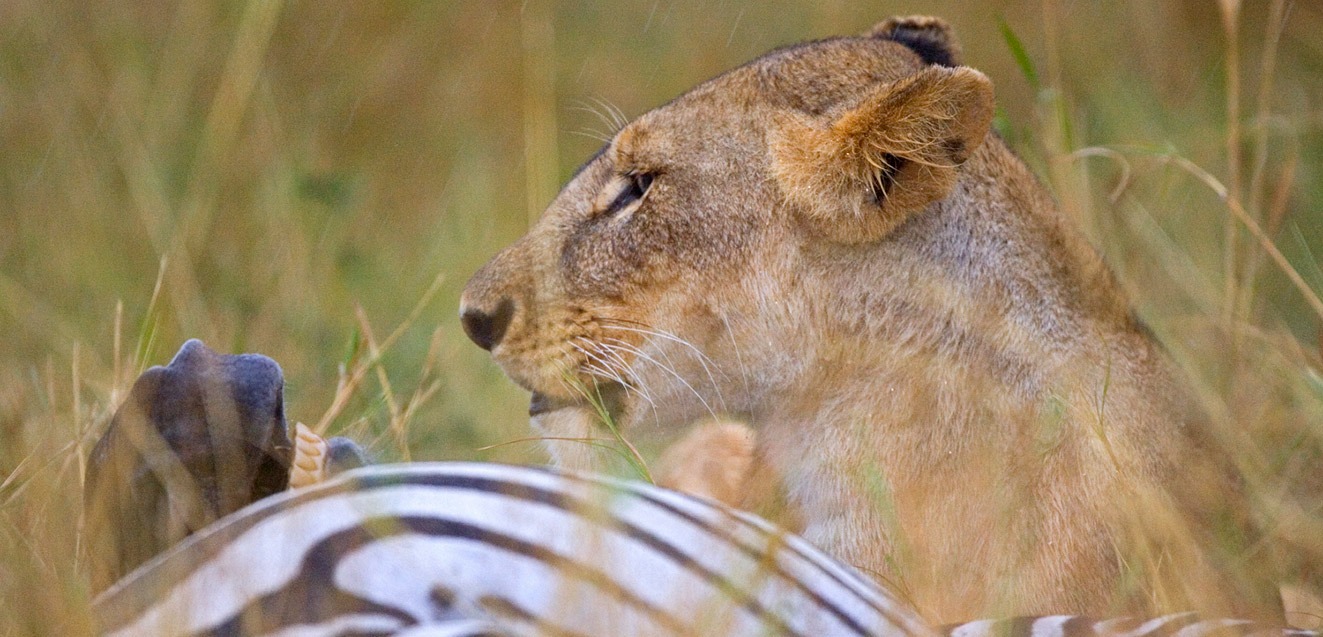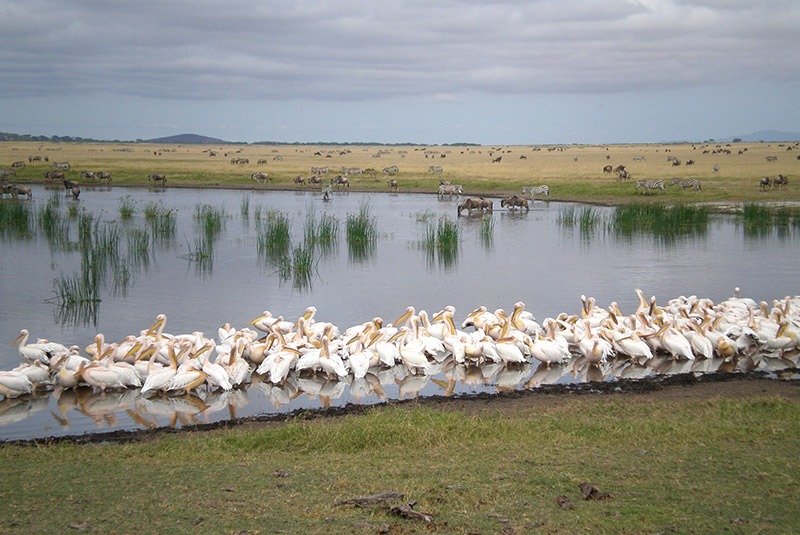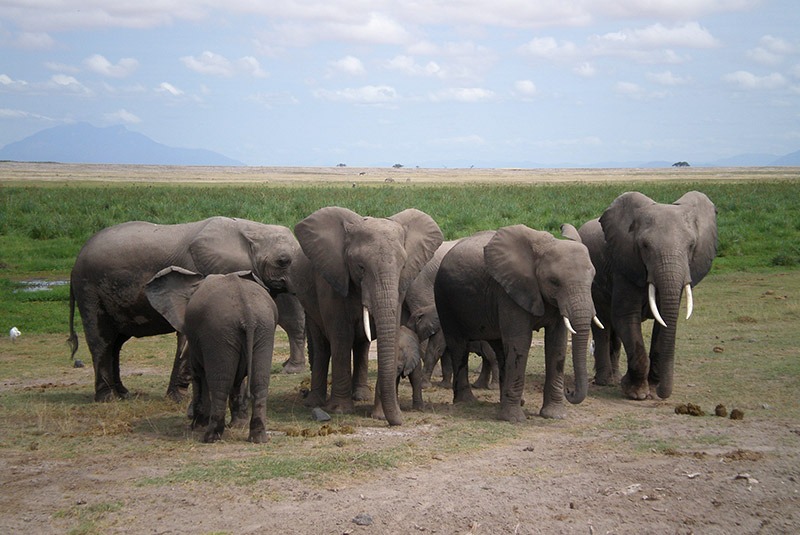Kenya Safari: Part Two – Dramas in the Bush

Following my recent conversation with Emily Barth and Matt Kukta about their unexpected honeymoon adventure in Kenya, I’ve been recalling a life-changing two-week safari to East Africa that I took in 2008. Below is the second in a series of dispatches I wrote on that Kenya safari.
AMBOSELI NATIONAL RESERVE — We’ve just stepped off an 18-seat Air Kenya propeller plane onto the airstrip at Amboseli National Reserve. Vast brown savannah surrounds us. A nearby herd of ungainly, big-horned wildebeest stares at the noisy, propeller-beaked bird that just disrupted their grazing. Beyond them sleek-striped zebra munch, flanks twitching, on the grass. To their distant left a trio of Thomson’s gazelles leap toward the green foothills of Mount Kilimanjaro, whose flanks disappear into masses of gray clouds.
I look at the three others on my safari and blurt out the only words that come to mind: “This is so . . . Africa!”
We climb into our minivan and set off for the tented camp where we will spend the next two nights. We’ve been driving for about 15 minutes when we come upon a swamp. Lewela, our safari director, suddenly points to the far shore, “Look! Over there!”
Four heads swivel. And there it is: Three feet from the water’s edge, a lioness is lying next to the bloody half-carcass of a zebra, the remains of the pride’s dinner. “They had a big party last night!” Lewela laughs as we stop to absorb the scene.
Another lioness is lying down about 20 feet away, sated, so exhausted from the effort of eating and digesting that we can hear her labored panting and see the bellows of her tawny body moving in and out. Soon a great African drama begins to unfold. First wiry jackals come on the scene, cautiously approaching the carcass, smelling the air, anxious in their hunger, waiting for an opening when they can dash in and make off with some lunch. Then two hyena come loping across the savannah, eyeing the lions, warily working their roundabout way toward the glistening kill.
For a long time the lioness lets them approach, head on paws, eyes closed, seemingly oblivious. Then she slowly raises herself, turns, and begins a purposeful stride in the direction of the jackals and hyenas. After a few taut seconds they scoot away, followed closely by the lioness’s eye. Then she returns to her resting place and curls up again next to the carcass. One of the jackals gives a disappointed yelp. Lunch will have to wait.
Another drama begins to play out in the swamp as the wildebeest and zebras start to cross. They enter the water in a line, following the leader across the depths and out to the opposite shore. But suddenly, about a third of the way into the swamp, one of the wildebeests begins to flail wildly. It has strayed off the path into deeper waters and bucks in terror for a few seconds before it finds its footing and splash-charges into shallower waters and onto the land. “During the Great Migration a lot of wildebeest die this way,” Lewela says. “Either they drown or they get separated from the herd and become easy prey. The lions wait by the rivers like they’re at a buffet.”

As he speaks, the next wildebeest in line hesitates, confused, then looks around, snorts and gallops back onto the land he’d just left. The one behind him stands still for a second, then belligerently wheels around and follows him back. Soon the entire line of wildebeest and zebra has beaten a retreat onto land, and the animals graze and gaze placidly, now on both sides of the water, as if nothing has happened.
In the foreground a flock of long-beaked, white-winged great white pelicans erupts as one into the sky, swerving over the sweeping brown-golden grass-plains and toward the line of hazy green-purple hills beyond. Acacia trees thrust their thorny branches into the sky, and giraffe, elephant, and Cape buffalo materialize in the distance. The smell of fresh dung carries on the breeze, mixing with the dry dusty earthy smell of the land. And Kilimanjaro broods over it all, massing in the clouds.
Africa!

* * *
We continue our game drive to Tortillis Tented Camp. When I had been preparing for this trip, the words “tented camp” had conjured visions of summer family camping trips, lightweight tents pitched by the campfire and freeze-dried meals cooked on camp stoves. So I am more than a little nonplussed—and delighted—when we pull up to the gracious, thatch-roofed main building at Tortillis and I am taken to my tented room. This is definitely not your typical summer family camp-trip site.
The tented accommodations at Tortillis are large comfortable permanent tents with thatched roofs. The canvas structures have mosquito-netting panels, roughly 3 x 4 feet, sewn in the sides so that you can leave them open to the breezes and bush sounds when you want, or zip them up. Each room has a private in-tent bathroom—forget those images of wandering warily across an open campground to go to the bathroom in the middle of the night—and a comfortable king-size bed. There’s a shower in the bathroom and a little attached verandah where I can sit and read if I want. Now that’s what I call camping!
After getting settled in our rooms, we gather back in the main building for lunch in the open-walled dining room. Tortillis is renowned for its commitment to eco-tourism, Lewela tells us, and in addition to its efforts to preserve the land and nurture the local Maasai community, the lodge also grows most of the food it serves. Lunch begins with a delicious tomato soup, followed by a spinach and cheese quiche, a lettuce and tomato salad, chicken pot pie, and wild brown rice with pineapples and raisins. The food is glorious—a far cry from the freeze-dried feasts of my Yosemite camping days—and somehow it tastes even better knowing that it’s come from the gardens just down the hill from where we eat.
* * *
Now it’s 3:15 p.m. and I’m sitting on my verandah, looking out on the snow-topped crown of Kilimanjaro—well, I would be, if the mountain would deign to appear—and the dry swaying grass of the savannah. A mid-afternoon torpor has settled over the scene. A slight breeze barely stirs the branches of the tortillis acacia trees that tower around my tent, casting long shadows over a dense tangle of green, insect-loud vegetation. The most energetic beings are the buzzing flies and the calling birds. There’s an amazing, sweet cacophony of bird calls—one that has a sandpapery grate to it, others high branch-strung tweets, others that woo-woo-woo…. To the east of cloud-massed Kilimanjaro rain sheets down in the distance.
A whiff of wetness is borne on the breeze, and the insects shrill with even greater intensity.
I look around and shake my head: It’s almost impossible to believe that this is just our first day in the bush. Who knows what wonders await?
* * * * *
Read the other blogs in this Kenya series: Part One: The Kiss of the Giraffe, Part Three: Under the Elephant’s Spell, Part Four: Kenya Connections, Part Five: Among the Maasai, and Part Six: Cheetah Time on the Mara Plains.GeoEx offers a wide range of small group and custom-designed luxury Kenya tours and safaris. For more information, call us today at 888-570-7108!

